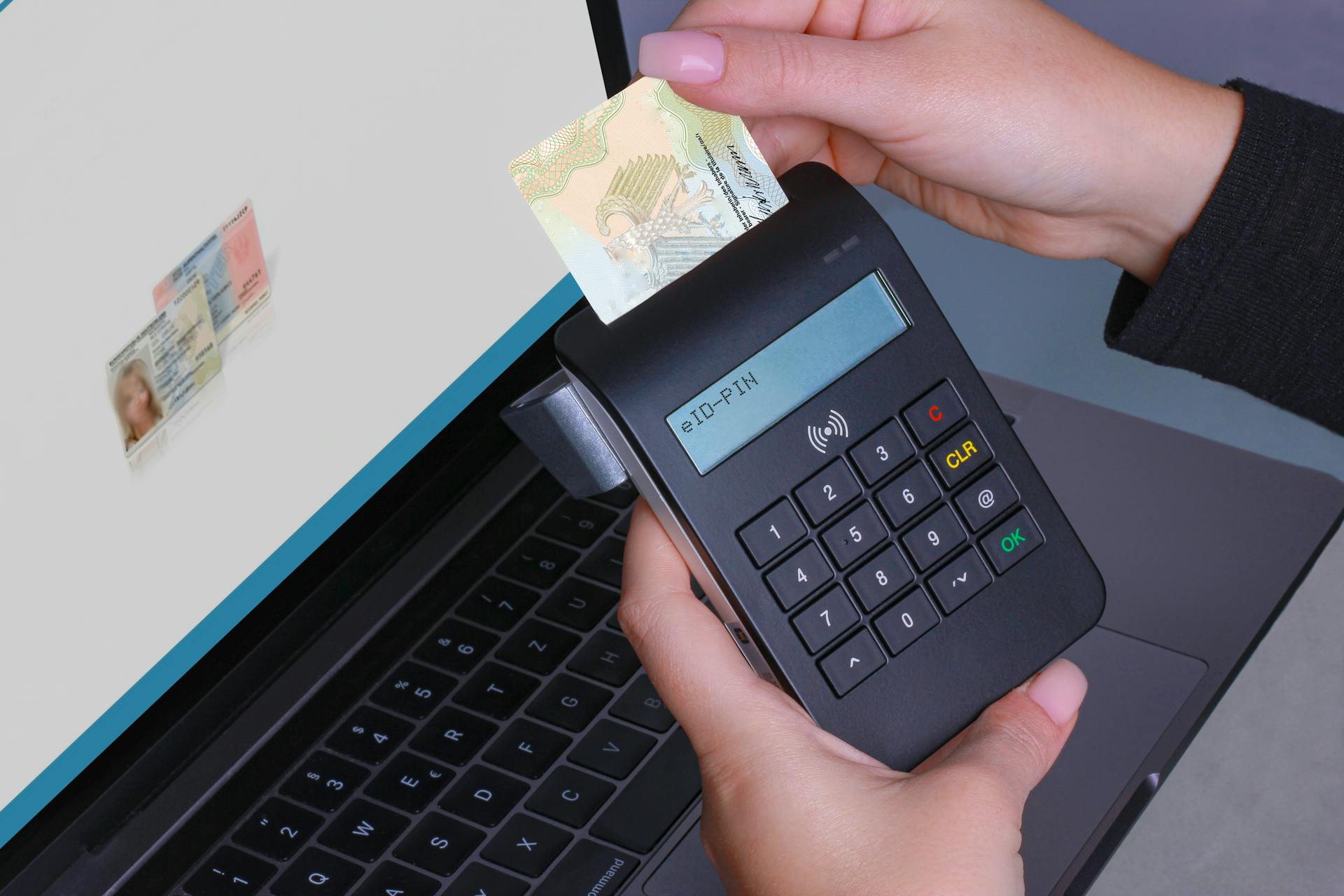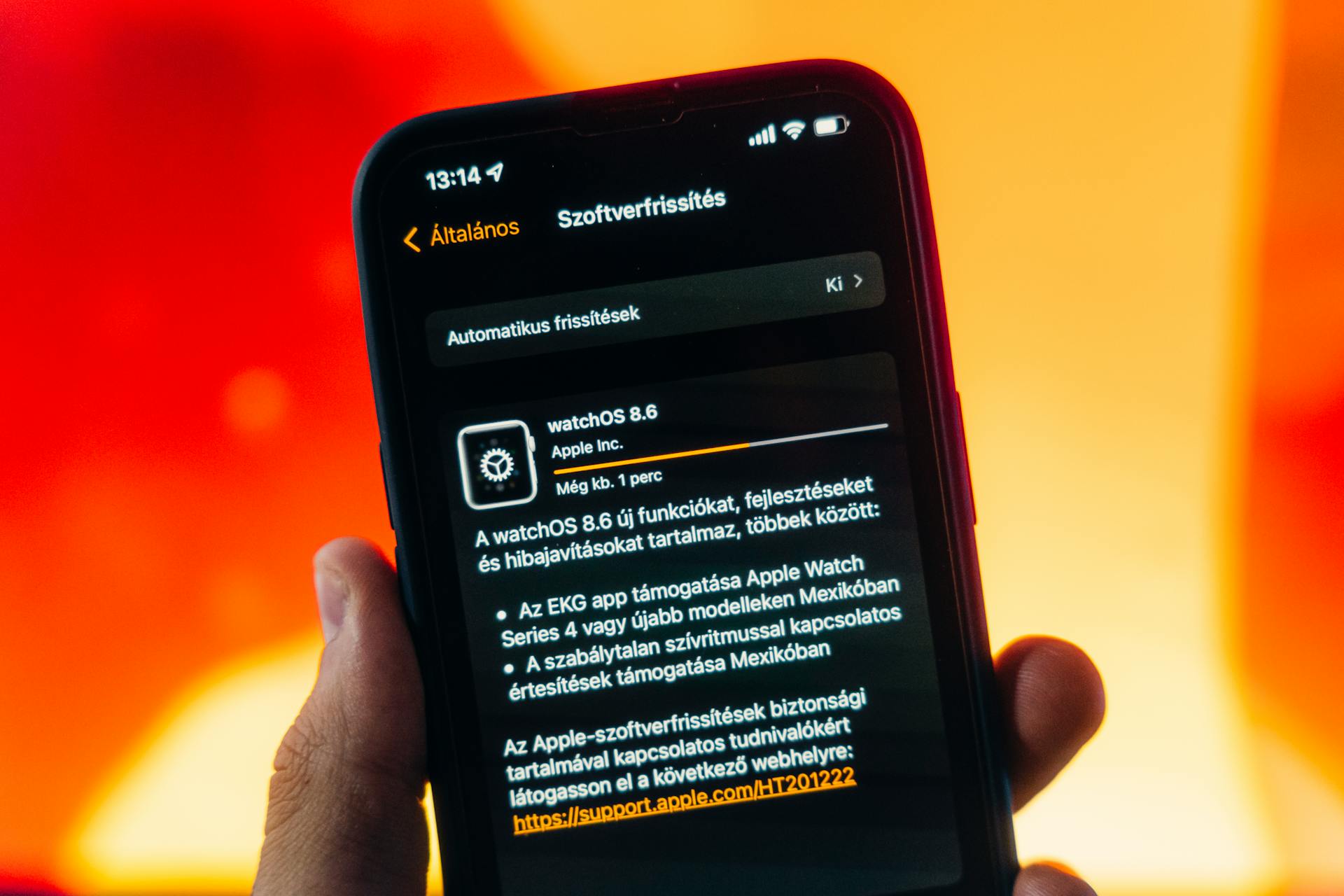
To do KYC (Know Your Customer) online, you'll need to provide personal and financial information to a financial institution or service provider. This information is used to verify your identity and assess the risk of doing business with you.
Most financial institutions require you to upload a government-issued ID, such as a passport or driver's license, as part of the online KYC process. You can usually do this through their website or mobile app.
In some cases, you may be asked to provide additional documentation, such as proof of address or employment verification. This is usually done to ensure that you're a real person and not just a fictitious account.
The online KYC process typically takes a few minutes to complete, and you'll be able to access financial services once you've successfully verified your identity.
A different take: Audit Risk Assessment Process
What Is
KYC verification is the process of identifying and verifying a potential customer's identity during onboarding, aiming to protect customers from identity theft and fraud, and financial institutions from money laundering and terrorist funding.
Additional reading: What Is Kyc Compliant
The objective of KYC verification is to ensure that a customer is who they claim to be.
KYC is a set of guidelines outlined by the United States Financial Crimes Enforcement Network (FinCEN), a mandatory requirement for financial institutions and many other businesses.
Elements of a KYC procedure typically include a customer acceptance policy (CAP), customer identification procedure (CIP), transaction monitoring, and risk management.
To verify a customer, it is minimally required to collect the following information: NameDate of birthAddressIdentification number
Documents such as a government-issued ID (driver’s license or passport) and public utility bills can be used for KYC verification.
Additional methods of identity verification can include the use of biometrics and face verification, as well as comparing the information the customer provides during onboarding with public databases, consumer reporting agencies, and watchlists.
Benefits and Purpose
KYC verification is a crucial step in protecting your organization from potential risks. It ensures that you're doing business with legitimate customers who are who they claim to be.
By performing a robust risk assessment, KYC verification helps mitigate potential losses or issues with high-risk entities. This can save your organization from significant negative consequences.
KYC verification can prevent identity theft by requiring customers to provide proof of their identity. It's harder for threat actors to open fraudulent accounts with stolen credentials or forged documents.
Financial fraud is a significant burden on organizations, costing around 5 percent of their annual revenue on average. KYC verification can help prevent this by blocking suspected terrorists from using financial services.
KYC verification tracks accounts and monitors transactions, sending an alert if suspicious activity is suspected. This helps prevent financial fraud and keeps your organization safe.
Here are some key benefits of KYC verification:
- Prevents identity theft by verifying customer identities
- Blocks suspected terrorists from using financial services
- Monitors transactions for suspicious activity
- Helps mitigate potential losses or issues with high-risk entities
The Process
To do KYC online, you'll need to register first. This is the starting point of the entire process.
The KYC process involves several crucial steps, including Profile Analysis, Other Information (Personal/Financial), Product Selection, Bank Details, and Documents Upload.
Broaden your view: Kyc Steps
You can complete your KYC formalities in just a few easy steps, which can be done in a matter of minutes. This is the key objective of e-KYC.
Here's a breakdown of the steps involved in completing your KYC for demat account online:
1. Entering Basic Details
2. PAN Step
3. Bank Account Verification Step
4. Digilocker/AADHAAR Card Step
5. Selfie Step
6. Signature Step
7. E-Sign/IPV Step
You can typically complete this process in three steps, involving the submission of a canceled cheque or manually entering account details, followed by verification.
Readers also liked: Uscis E Verify Check
Preparation and Documents
To complete your KYC online, you'll need to gather the necessary documents. These include your PAN Card, which is mandatory for all financial transactions and serves as primary proof of identity.
To verify your identity, you'll need a Passport size Photograph, and you can use any one of a PAN card, Aadhaar Card as your Identity Proof.
Aadhaar Card simplifies the process and ensures a seamless and secure pathway to financial empowerment. You can also use Passport, Driving Licence, Aadhaar Card, Bank Statement, or Utility bills as your Address Proof.
A fresh viewpoint: Virtual Crypto Card No Kyc
You may need to provide Income Proof, which can be any one of a Salary slip (latest), ITR (latest), or Bank Statement (6 months). Account Linking requires a Cancelled Cheque.
Here's a summary of the documents you'll need:
- Mandatory Documents - Pan Card and Passport size Photograph
- Identity Proof - any one of PAN card, Aadhaar Card
- Address Proof - any one of Passport, Driving Licence, Aadhaar Card, Bank Statement, Utility bills
- Income Proof - any one of Salary slip (latest), ITR (latest), Bank Statement (6 months)
- Account Linking - Cancelled Cheque
Verification Methods and Policy
The CIP process involves performing customer due diligence, which is essential for verifying the identity and assessing the risk of doing business with a customer.
Basic customer due diligence (CDD) is used on most customers, verifying their identity and assessing their risk threshold. Higher-risk customers may require enhanced due diligence (EDD), which examines the customer and their records more closely.
For customers with a higher AML risk threshold, beneficial owners with at least 10 percent equity interest in the company must be identified and verified. This percentage drops to 25 percent for other customers.
Information collected during the due diligence process must be maintained by financial institutions. EDD often requires senior management approval and is more in-depth than CDD.
KYC verification can be supported through a CIAM solution, making the process seamless for the consumer and supporting KYC compliance for the organization.
Consider reading: Kyc Cdd Edd
Eligibility and Journey
To open an online Savings Account using Video KYC (V-KYC), you need to meet certain eligibility criteria. Only Tax Resident Indian Individuals aged 18 and above can open this account.
Here are the key eligibility factors to consider:
- Aged 18 and above
- New to Bank (NTB) customers
- Not a politically exposed person
- Account can be opened in single name and operated by self only
- Not lunatic and blind
Being a new customer to the bank is a crucial factor, as existing customers cannot open their account online due to a dedupe check in the system.
Eligibility
To open an online Savings Account using Video KYC, there are certain eligibility criteria you need to meet.
Only Tax Resident Indian Individuals aged 18 and above can open this account.
You'll need to be a New to Bank (NTB) customer, as existing customers are not eligible to open a new account. This is due to a dedupe check in the system.
You should also not be a politically exposed person.
The account can only be opened in a single name and operated by yourself.
You'll need to be mentally fit to open an account, meaning you should not be a lunatic or blind.
For more insights, see: Kyc Account
Journey

The journey to achieving your goals is just as important as the destination itself. According to the eligibility criteria, the journey typically begins with a thorough evaluation of your skills and experience.
A significant amount of time is spent on the assessment process, which can take anywhere from a few weeks to several months. This allows for a comprehensive review of your qualifications.
Your journey will also involve regular check-ins with the program administrators to ensure you're on track and address any questions or concerns you may have. This level of support is designed to help you succeed.
The journey is not a one-size-fits-all approach, as the program is tailored to meet the unique needs of each individual. This means that your experience will be distinct from others who have gone through the program.
With dedication and hard work, you can successfully navigate the journey and achieve your goals.
Additional reading: Kyc Program
Frequently Asked Questions
How to do KYC online for NRI?
To complete KYC online for NRI, visit the iNRI website, login/signup with your email ID, and follow the verification and registration process. This includes verifying your email, entering personal details, and checking your PAN number for KYC compliance.
Sources
- https://www.reliancesmartmoney.com/online-kyc-registration
- http://www.sharekhan.com/financial-blog/blogs/how-to-complete-kyc-update-online-easily
- https://www.okta.com/identity-101/kyc-verification/
- https://www.bankofbaroda.in/personal-banking/accounts/saving-accounts/online-savings-account-using-video-kyc
- https://www.sbimf.com/kyc-procedure
Featured Images: pexels.com


